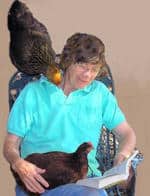 By CARY NEEPER
By CARY NEEPERFormerly of Los Alamos
An Ethogram is a chart that lists the kind of mental activity observed in animals: Tool using? Reflection? Problem solving? Flexible decision-making? Thinking? In his Great Course, “Zoology: Understanding the Animal World,” Donald E. Moore III explores some interesting suggestions.
Do animals use tools? That is no longer in question for some, especially the untrained crows that choose appropriate visible tools to reach other tools of more appropriate size that allows them to reach visible treats deep in a plastic box. Tool use was rarely questioned after Jane Goodall’s observation of chimps creating stick tools to fish for ants in deep holes.
In my Hen House experience I had good reason to believe that Mrs. Campbell (the duck) knew where I kept a trowel that I could use to dig into wet dirt and provide her a mud ball loaded with big juicy worms.
Do animals reflect, i.e. think seriously–have “carefully considered thoughts?” (American Heritage College Dictionary) I could say that Ms. Campbell certainly had a clear plan in mind when she came to me, looked me in the eye, then walked over to my trowel before looking at me again. When I picked up the trowel, she didn’t hesitate to walk over to the wet part of the pen and look at me again. This happened several times after it had rained.
Our dogs–all of them over the years–knew the word “car” and “reflected” clearly on what our question meant. The answer erupted with eager tail-wagging and running to the car–”reflecting” clear “anticipations.” Dogs, however, don’t seem to have a clue about how to get a treat from a plastic box.
But then, perhaps birds have had to evolve such talents to survive in the wild? Survival challenges probably played a large role in bird brains learning solution-seeking talents. Dogs have learned to relate with humans very well, but they can’t recognize themselves in a mirror, as human babies do at 18 to 20 months.
How much of this kind of brain activity is “thinking?” The definition of that word is not simple; it can suggest a means necessary to change behavior. My dictionary says “thinking’ is a “way of reasoning; judgment.” The phrase “to think” lists various definitions that include “formulate, reason about, reflect, judge or regard, suppose, expect, remember, imagine, invent or concentrate.” Intransitive choices include “to reason, to consider, to image, and to believe.”
To know a dog, or any animal, is to believe that their minds engage in at least one of these options. Perhaps that could suggest what life and having a brain can mean–thinking. I say that our geese, Lucy and Bobbi, certainly had the ability to reflect, consider, and judge when I grabbed them and proceeded to fix a sore foot or take them through the deep snow and into the house for a swim in the tub. Certainly the dogs remembered what the car was for. It would be fun to go on and on with examples of “thinking” we have all experienced in animals.

